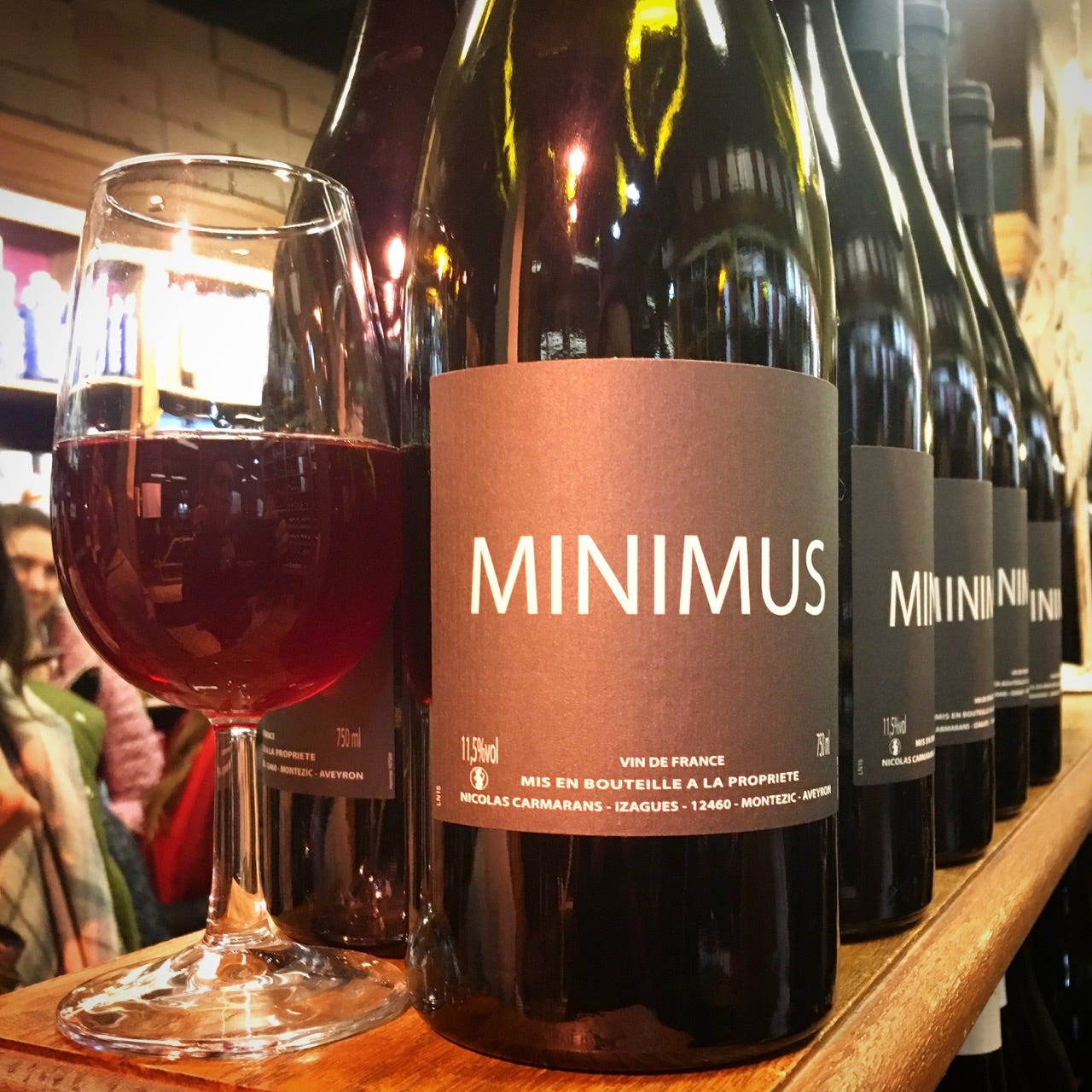Nicolas Carmarans' "Minimus" Primeur 2018 at Les Caves de Panthéon 75005
The greatest primeur wine I tasted this year derived not from that region's gamay, but from fer servadou, the dark, ferrous native red grape of Aveyron.
At the risk of being pelted with grattons the next time I set foot in the Beaujolais, I'll confess the greatest primeur wine I tasted this year derived not from that region's gamay, but from fer servadou, the dark, ferrous native red grape of Aveyron. Nicolas Carmarans' - former proprietor of the historic Café de la Nouvelle Mairie, presently the natural wine standard-bearer of the high hills of Aveyron - made an utterly showstopping vin nouveau this year. Most of it was drunk at a Beaujolais Nouveau celebration held at Olivier Roblin's Les Caves de Panthéon, not far from Carmarans' old haunt in the 5ème arrondissement. (On which more later.)
Rather confusingly, Carmaran's primeur is called "Minimus," the same name he habitually uses for his rosé production. (I assume it was a case of him not wanting to print a new label for a wine that was destined to vanish within days or weeks. Production was something like 300 bottles, as I understand.)
One thing distinguishing Carmarans' 2018 "Minimus" primeur from most other primeurs on earth - including those from most celebrated natural winemakers - is the fact it was unfiltered. Even among the experienced winemakers of the Beaujolais, I can name just a handful who regularly produce unfiltered primeur wine - Guy Breton, Romain des Grottes, Christian Ducroux, Xavier Benier last I tasted, in recent years Romuald Valot. (Yann Bertrand made one once - in 2016 - and it was a beauty.)
Why are unfiltered primeurs so rare? Because simple, inexpensive primeur wines are, ironically, among the most difficult wines styles to produce. Winemakers face the same winemaking challenges, only under an insanely short deadline. The perennial popularity of Beaujolais Nouveau on the export market makes it doubly important for most winemakers that their wines be clean, limpid, and stable for transport by late October, just weeks after the harvest in most cases. It was no accident that in the late 20th century Beaujolais Nouveau became the scapegoat for wine adulteration; few other systems of wine sales create such incentives for winemakers to sacrifice quality for stability in transport. Filtration is just such a sacrifice, whether applied to primeur wines or later releases.
The wholesome, unfiltered purity of Carmarans' "Minimus" is visually perceptible the moment it catches the light between the bottleneck and the glass - the difference between a rough ruby and a rhinestone. The wine is enriched with its just-finished fermentations. The sanguineous red fruit emanating from the glass was crystalline in its nuance. A truly perfect, honest, unfiltered primeur like this is transportive, in the emotional sense - it is an uncelebrated, little-known truffle of a bygone era of wine commerce.
Carmarans harvested on October 12th, he said. A quick carbonic fermentation, sealed with CO2, before pressing and placing the juice in a fiberglass tank. "We put it on the north side of the cuvage, like Marcel Lapierre taught me. It gets cold up there in the mountains at 500m."
The evening of Beaujolais Nouveau this year in Paris was also noteworthy for what was missing, namely, a party at the Café de la Nouvelle Mairie, which was sold to new ownership over the summer. For the past several decades that restaurant had been the city's cornerstone of natural Beaujolais Nouveau and natural wine itself, first under Bernard Pontonnier, then Nicolas Carmarans himself, then until recently the duo of Benjamin Fourty and Corentin Bucillat.
The Café de la Nouvelle Mairie is a two minute walk from Les Caves de Panthéon, so everyone in the room at the latter establishment knew what was different this year. Everyone seemed all the more thankful that Carmarans - and Olivier Roblin - had found a way to continue the tradition of la fête des primeurs - along with the almost vanished tradition of true unfiltered primeur.
Les Caves de Panthéon
174 Rue Saint-Jacques
75005 Paris
FURTHER READING
Sébastian Lapaque's July 2018 profile of Carmarans in Le Figaro is behind a paywall, unfortunately. Lapaque remarks, "There are a lot of brasseries kept by people from Aveyron in Paris, but it's at Saturne, Vivant, and the restaurants of Jean-François Piège or Yves Camdeborde where one drinks the wines of Carmarans." (My translation.)
Bert Celce's definitive 2012 profile of Carmarans at Wine Terroirs.
My 2016 review of Les Caves de Panthéon at Paris By Mouth. My suddenly outdated 2018 review of Café de la Nouvelle Mairie at Paris By Mouth.





